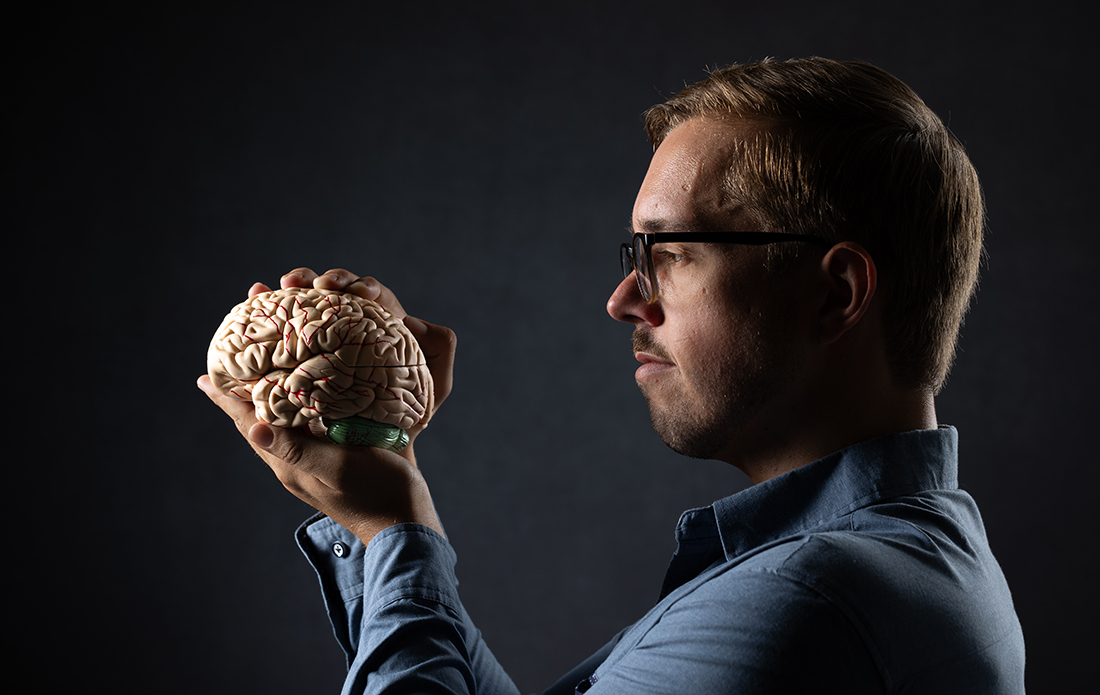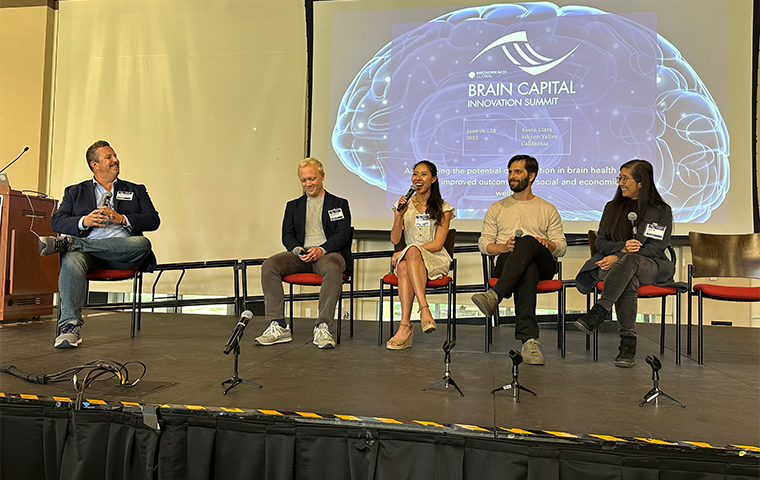'Democratizing' Brain Health Research

It’s part of the routine of an annual physical check-up: measuring your weight, your blood pressure, and your pulse.
But what if a diagnostic tool could quickly target your brain health?
That’s what Soren Madsen ’21, a co-founder of Axon Interfaces, envisions with a non-invasive instrument the company is developing to detect early warning signs of Alzheimer’s disease. Axon wants to replace expensive brain imaging and spinal fluid tests with a routine 10-minute scan using a cap or headband with electrodes attached to a Bluetooth transmitter.
“We’re essentially putting tiny antennas on your head to pick up large populations of neurons firing in your brain,” says Madsen, who also serves as chief technology officer.
Just like our muscles slow down with age, so does our brain activity—even more so when Alzheimer’s surfaces. By tracking that progression, interventions can be introduced before the irreversible damage of the disease occurs.
While the young company has the potential to change an industry with its technology, it’s a work in progress.
But at Santa Clara's first-ever “Brain Capital Innovation Summit” this June, Madsen got a surprising confirmation from Mark D’Esposito, M.D., a renowned U.C. Berkeley professor of neuroscience and psychology. At one point during the keynote, D’Esposito—father of Zachary D’Esposito ’22—talked of the need for a device that could be placed on someone’s head to easily track cognitive health. In other words, the exact type of system Axon is designing.
Following the discussion, Madsen made a beeline to D’Esposito to discuss Axon’s goals. It was a quick chat, Madsen says, “but he was very willing to help and talk.”
For Santa Clara, possibilities for partnerships—and more
That’s the kind of cross-pollination Julia Scott, director of Santa Clara’s Brain and Memory Care Lab, and Prashanth Asuri, director of SCU’s Healthcare Innovation and Design Program, envisioned when they helped organize the inaugural symposium with Brain Capital Alliance and Broadreach Global. The event was one of the first transdisciplinary brain health gatherings on the West Coast, and many of the attendees then convened at the United Nations General Assembly (UNGA) Science Summit in September to announce major initiatives that aim to advance brain health in California and globally.
Together with Scott, lead organizers Harris Eyre, M.D., Ph.D., founder of Brain Capital Alliance and Fellow at Rice University’s Baker Institute for Public Policy; Christian Suojanen, CEO of Broadreach Capital; and California Mental Health Commissioner Steve Carnavale, built a diverse program that challenged the status quo on brain health.
The three-day summit focused on the latest strategies, policies, and public-private partnerships accelerating innovations in brain health. Experts in neuroscience research, neurology, psychiatry, and technology discussed topics from dyslexia to autism spectrum disorder to Alzheimer’s disease, and how to deliver innovative ideas and best practices of care to the public at scale.

Christian Suojanen leads a panel discussion at SCU's Brain Capital Innovation Summit. Photo courtesy Julia Scott.
“Julia and her colleagues at Santa Clara are doing some really great work,” says Carnavale of the electroencephalogram (EEG) technology which is part of Scott’s methodology in virtual reality and neurofeedback. “And what’s interesting about it is that they can prove out what they are doing. They’re having terrific results.”
Like Scott, Madsen is part of a movement in Alzheimer’s solutions at Santa Clara. As Scott’s graduate research assistant over the last year, he focused on digital signal processing of EEG in neurofeedback devices. While universities with medical schools can test surgical implants in human brains, he says Santa Clara’s focus on these and other non-invasive technologies can “democratize the brain” because SCU’s solutions are accessible and affordable to more people.
“That’s where I think Santa Clara has a huge opportunity,” explains Madsen, “to capitalize on what Dr. Scott is doing, and what Dr. Asuri and students and other faculty are working on, to supplement the research on the other end of the spectrum.”
In his pitches to investors, Madsen is already using D'Esposito's name. And he’ll use it again on Oct. 13 during Santa Clara’s Bronco Venture Accelerator's “Demo Day,” a kind of “Shark Tank” event on campus, where stakeholders will do their best to convince any of 400 investors to back their idea or company.
How your brain “sings a tune”
It’s early, but Axon’s software is already showing promise in tests against publicly available Alzheimer’s case data, achieving an 89 percent match. Specifically, the software tracks brain patterns in the rhythms of electrical activity correlated with Alzheimer’s.
“Your brain is singing a tune, and it’s got all sorts of frequencies. We’re analyzing how complex these frequencies are,” Madsen explains. “If it’s singing a really simple tune, chances are your brain is not performing as well.”
The company believes the earlier people get scans as part of their annual medical check-ups—starting around middle age—the sooner detection and intervention can begin. Axon has partnered with Emory University to acquire more patient data and invite interested clinicians to work with the Palo Alto company.
It’s that kind of experience at the brain health summit that can turn a standout student like Madsen into an entrepreneur. And it’s why Scott is working to bring the conference back to the University next year.
“We want to show what we can bring to the table here with the work we already do at Santa Clara,” Scott says of SCU’s expertise in neuroscience, public health, bioengineering, and its Healthcare Design and Innovation program. “The summit was about opening up possibilities for partnerships.”
Since the symposium, several new developments have occurred. Chief among them is the announcement of the “Brain Capital Industrial Strategy” written by Dr. Eyre, with Scott as a contributor, at the UNGA Science Summit. The strategy focuses on building economic resilience by emphasizing how cultivating brain health and brain skills can contribute to an innovative and thriving economy.
To Madsen, that’s another powerful example of how Scott’s efforts around the summit are already paying off.
“Dr. Scott took all these big players and key opinion leaders in the arts and the sciences and engineering and put them together in one room and said, ‘You all need to talk to each other because you have the recipes for something really, really, phenomenal.’”
The Healthcare Innovation and Design program empowers students, faculty, and community to address complex challenges in healthcare.
Learn More About the Healthcare Innovation and Design Program.